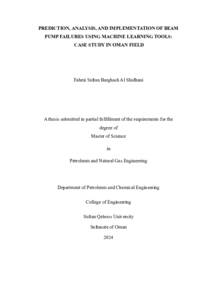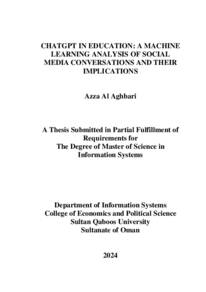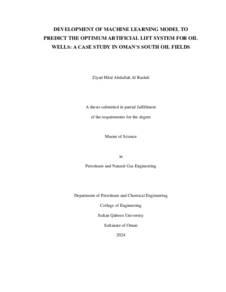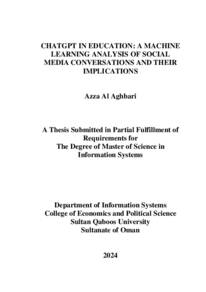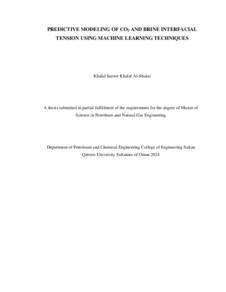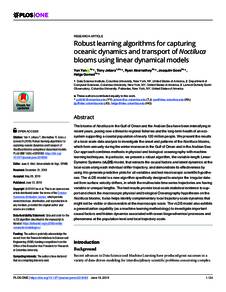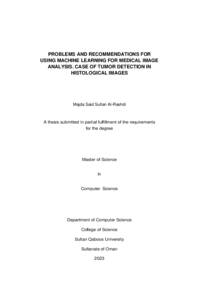Document
Prediction, analysis, and implementation of beam pump failures using machine learning tools : case study in Oman field.
Source
Master's thesis
Other titles
التنبؤ والتحليل والتنفيذ لي أعطال مضخة الBP باستخدام أدوات التعلم الآلي : دراسة حالة في حقل عمان
Country
Oman
City
Muscat
Publisher
Sultan Qaboos University
Gregorian
2024
Language
English
Thesis Type
Master's thesis
English abstract
The Beam Pump (BP) or the Sucker Rod pump is used for low, medium to high
production rates, the most effective and dependable artificial lift technique. Even
though BP has a low to medium capital cost, the production losses brought on by its
failure are significantly higher. Machine learning (ML) is a subfield of artificial
intelligence that has obtained significant interest in the oil and gas sector due to its
capacity for prediction. The goal of this research is to create an ML model that can
forecast BP failure and pinpoint the critical elements that affect it. A general review is
conducted for the BP failure analysis approach, monitor, troubleshoot and predict its
failure. The study explores various ML algorithms and their applications in predicting
the failure type of BP in different fields around the world. The aims of this thesis were
directed through BP static and historical data to be achieved based on the literature
review. The failure history of around 573 wells from an Omani oilfield was reviewed,
all of the wells are BP failures attributed to sand, mechanical failure and scale
accumulation. The dataset includes static features and dynamic features related to BP
performance, design, installation, commissioning, failure, pull-out and teardown. Data
split into training and testing sets by a ratio of 70:30. Tests were performed to three
selected algorithms to optimize the parameters, based on accuracy, precision, and true
positive rate. The algorithms tested were Decision Tree (DT), Random Forest (RF),
and K Nearest Neighbors (KNN). After determining that the final model's accuracy
was very high and promising, it was decided to deploy and implement the idea into
TIBCO Spotfire, a visualization tool that offers various ideas to predict model failure.
However, human intervention will be required to adjust the parameters in accordance
with the high risk ranking whenever the tool provides us with a high rank, allowing us
to work proactively and prevent any pump failures. We were able to lower the number
of failures in a year thanks to the developed Spotfire tool, and our goal going forward
is to lower the number of failures even further to cost on failure maintenance, new
pump installations, hoist intervention, and down oil lost per barrel. The pump fillage,
minimum load, and peak load are the most crucial parameters to keep an eye on and
regulate. Through human intervention and the scheduling of preventive and corrective
maintenance for BP wells, we can minimize and eliminate failures and take proactive
measures to identify and isolate high-risk wells.
Arabic abstract
يتم استخدام مضخة الانتاج )BP )أو مضخة (Rod Sucker (لي إنتاج منخفضة أومتوسطة إلى عالية، وهي تقنية رفع الانتاج من باطن الارض الى السطح عن طريق الرفع الاصطناعي الاكثر فعالية، والمعروفة أيضا باسم مضخة (pump Rod Sucker(. وعلى الرغم من أن تكلفة المضخة منخفضة إلى متوسطة، الا أن خسائر الانتاج الناجمة عن خرابها أو فشلها أعلى بكثير. التعلم الالي ) Machine Learning )هو مجال متفرع من الذكاء الاصطناعي الذي حظي باهتمام كبير في قطاع النفط والغاز بسبب قدرته على التنبؤ في السنوات الاخيرة. الهدف من هذا البحث هو إنشاء نموذج (ML( يمكنه التنبؤ بفشل المضخة وتحديد العناصر الحاسمة أو الساسة التي تؤثر على المضخة بطريقة مباشرة أو غير مباشرة. يتم إجراء مراجعة عامة لنهج تحليل فشل المضخة ومراقبته واستكشاف الاخطاء وإصالحها والتنبؤ بفشلها. تستكشف الدراسة خوارزميات (ML (المختلفة وتطبيقاتها في التنبؤ بنوع فشل المضخة في مجالات مختلفة حول العالم. تم توجيه أهداف هذه الاطروحة من خلال البيانات المخزنة لكي يتم تحليلها. تمت مراجعة تاريخ الاعطال لحوالي 573 بئ ًرا من أحد الحقول النفطية العمانية، وكانت جميع الابار عبارة عن أعطال سببها عدة عوامل منها الرمال والعطل الميكانيكي وتراكم الحجارة الصغيرة. تتضمن البيانات من أداء، وتصميم، وتركيب، وتشغيل، وفشل، والسحب وتفكيك المضخة. تم تقسيم البيانات إلى مجموعة الاختبار والتدريب بنسبة .70:30 أيضا تم أختيار ثالث خوارزميات مختارة.، كانت الخوارزميات التي تم اختبارها هي (DT (Tree Decision، و(RF (Forest Random، و K (KNN (Neighbors Nearest. أظهرت دقة النماذج النهائية بنسبة عالية جدًا ، ثم قررنا تطبيق الفكرة وتنفيذها في أداة عملي عن طريق برنامج يسمى Spotfire TIBCO بأفكار مختلفة للتنبؤ بفشل المضخة ا لتصنيف عن العمل بشكل صحيح أو مطلوب، من خلال التدخل البشري وضبط العناصر المطلوبة وفقً الخطورة كلما أعطتنا الاداة تقييم عالي الخطورة للعمل بشكل استباقي وتجنب أي فشل أو عطل للمضخة. من خلال أداة Spotfire المطورة، تمكنا من تقليل عدد حالات العطل للمضخات خلال عام واحد، والخطة المستقبلية هي تقليل المزيد من حالات العطل لتوفير تكلفة صيانة الاعطال، وتركيب المضخات الجديدة، وتكلفة التدخل في الرفع، وتقليل كمية التفط المفقودة لكل برميل. أهم الميزات التي يجب مراقبتها والتحكم فيها هي الحمل الاقصى للمضخة، والحد الادنى للحمل، وملء المضخة. ومن خلال التدخل البشري وجدولة آبار النفط للصيانة الوقائية والصيانة التصحيحية، يمكننا تقليل العطل والتصرف بشكل اس تباقي للحد من أعطال الابار. يمكن أن تساعد على تخفيف التكاليف الرأسمالية من خلال جدولة صيانة المضخة قبل الفشل لإطالة حياتها.
Category
Theses and Dissertations

